学术英语(教师资料)_Unit3
- 格式:ppt
- 大小:536.50 KB
- 文档页数:24

Unit 3 Business EthicsI Teaching ObjectivesAfter learning Unit 3, students (Ss) are expected to develop the following academic skills and knowledge:II Teaching Activities and ResourcesReadingText ALead-inTeaching StepsAsk Ss to work in groups and complete the task in Lead-in. Then choose some groups to share their answers with the whole class.Answer Keys (Suggested Answers)1.Corporate Social Responsibility (CSR) can be defined as a self-regulatingbusiness model that helps a company be socially accountable —to itself, its stakeholders, and the public. In other words, it is the continuing commitment by business to behave ethically and contribute to economic development while improving the quality of life of the workforce and their families as well as of the local community and society at large.2.Text AnalysisTeaching Steps1.OverviewAsk Ss to preview Text A before class. Or, allocate some time for Ss to read the text quickly in class. Then invite several Ss to summarize the main idea of Text A.2.In-Depth Analysis1)Show Ss the following words and ask them to contribute to the class as muchas possible with what they know about these words. Provide additional information in Supplementary Information when necessary.•economic system•free enterprise2)Explain some important language points in Language Support to Ss.3)Discuss with Ss the features of the two versions of Adam Smith’s theory bydoing Task 1 in Critical reading and thinking.4)Organize a group discussion about the questions from Task 2 in Criticalreading and thinking. Encourage Ss to think independently, critically and creatively and share their ideas with each other.Supplementary Information1.economic systemAn economic system is a system for producing, distributing and consuming goods and services, including the combination of the various institutions, agencies, consumers, entities that comprise the economic structure of a given society or community. It also includes how these various agencies and institutions are linked to one another, how information goes between them, and the social relations within the system.Two of the basic and general economic systems are market economy and planned economy. Market economy is an economic system in which businesses and individuals decide what to produce and buy, and the market determines quantities sold and prices, whereas planned economy is an economic system in which decisions regarding production and investment are embodied in a plan formulated by a central authority, usually by a public body such as a government agency.Although a planned economy may be based on either centralized or decentralized forms of economic planning, it usually refers to a centrally planned economy.2.free enterpriseFree enterprise refers to the system of business in which individuals are free to decide what to produce, how to produce, and at what price to sell.Language Support1.Most academics today subscribe to the following modified version of AdamSmith’s theory:…(Para. 2)In the text, the phrase “subscribe to”means “agreeing with or supporting (an opinion, theory, etc.)”(同意;赞成).e.g. I subscribe to the idea that voting is my civic duty.She subscribes to the theory that some dinosaurs were warm-blooded andothers were cold-blooded.It can also refer to “paying money to get (a publication or service) regularly”(订阅).e.g. I subscribe to several magazines.We have subscribed to an evening newspaper.2.These constraints take a number of different forms. …Another set ofconstraints …(Para. 3)Two recent examples dramatically illustrate these points. First, …(Para. 3) Classification is employed to organize things into categories with a single organizing principle, and give examples of things that fit into each category. Here are other commonly-used words and expressions for classification:•The first (kind/type/group/class/etc.) …; the second …; the third …•sort, classify, categorize …•category, group, class, kind …3.Saving the financial system required a bailout of the banks and otherfinancial companies, and that bailout imposed huge costs on the taxpayers, and also helped push the economy into a deep recession. (Para. 5)impose sth. on sb.:i) force something on someone把......强加于e.g. He always imposes his opinion on others.ii) levy a tax or duty征税e.g. It is therefore necessary for governments to impose a higher tax on this kindof food.Here is another usage of the word “impose”:impose on sb.:i) force oneself on others强加于人e.g. Thanks for your offer to help, but I did not want to impose on you.ii) take unfair advantage of 利用e.g. Don’t you think you are imposing on your neighbor when you use histelephone for half an hour?4.be true to one’He is always true to his word and focused on the big picture.Ninety days later, true to his word, the goldsmith brought the crown.5.To date, Buffett has contributed more than $6 billion, and over time he isscheduled to contribute additional stock that is now worth in excess of $40 billion. (Para. 7)in excess of: greater than, more than 超过e.g. Luggage in excess of 100 kg will be charged extra.This plane can reach speeds in excess of 1000 kilometers an hour.Answer KeysCritical reading and thinkingTask 1 / Overview1The original version:The invisible hand; Profit maximization; Free enterprise systemThe modified version:the wealth of its stockholders; the best economic system; constraints2Argument 11) a wide range of regulations are imposed2) assessing costs on companies; BP oil spillArgument 21) behave ethically; value and reputation2) Don’t Be Evil3) creative capitalism4) contributed more than $6 billionTask 2 / Points for discussion (Suggested Answers)11) Yes, I agree. Because:• Earning profit is the main aim of every economic activity. A business is an economic activity and hence, its main aim should be to earn profit.• Profit is a measure of eff iciency and economic prosperity of the business. This justifies the concept of profit maximization.• Economic conditions do not remain the same all the time. A business can retain its profit so that it can survive the adverse situations in the future. Profit gives protection against future risks and uncertainties.• Profit is the main source of finance for growth and expansion. Profit is essential for the business in order to invest in new business propositions.• Profitability is essential for fulfilling the social goals of the business. With profit maximization a business can do socio-economic welfare and follow its policies of corporate social responsibility.2) No, I don’t agree. Because:Business should do anything they can to make a profit, but never at the cost of human welfare and natural environment. Human welfare must be considered as important as profit making. A business is successful to the extent that it provides a product that contributes to happiness in all forms. As a matter of fact, the great value of a business should be morally associated with consumer’s satisfaction and safety. On the other hand, businesses of great value should not be blind to their moral obligations of protecting the natural environment.2 Yes, it is a very effective way for society to impose such regulations to prevent companies from engaging in practices that hurt society. For most businesses their ultimate goal is to make profits. It is true that most businessmen try to abide by the laws while making profits. However we have to admit that there are some who use every means to make as much money as possible, even regardless of the interests ofemployees, communities, and environment. Therefore, the regulations such as penalties and suspension for internal rectification should be imposed to deter companies from unlawful practices.3 Yes, having a good reputation with customers, suppliers, employees and regulators is essential if value is to be maximized. Business success is associated with many entities, such as customers, suppliers, employees and regulators. If customers are satisfied with your products and service, they will be loyal to your company. If suppliers provide you with qualified products, your business will operate well. If employees are treated well, they will work very hard and are willing to be part of your company. If regulators are certain that your company acts fairly and follows rules, your company will develop sustainably. All above depends on whether the business is continually operating with society’s interests in mind and maintaining a good reputation.Language building-upAnswer keysTask 1 / Specialized vocabulary11 纳税人2 自由企业制度3 股东4 经济体制5 市场力量;市场调节作用6 金融机构7 stock price 8 mission9 corporate motto 10 assets11 profit maximization 12 financial system21 financial institutions2 free enterprise system3 assets4 Taxpayers5 stockholder6 profit maximization7 economic system 8 market forcesTask 2 / Academic vocabulary1. principal2. dramatically3. academics4. maximization5. framework6. range7. compensate 8. transfer9. inadequate 10. constraintsTask 3 / Collocations1. subscribe to2. striving to3. imposing …on4. go out of business5. as a whole6. engaged in7. go hand in hand with 8. in excess ofTask 4 / Formal English1 insights2 subscribe to3 imposes4 adverse5 mission6 philanthropic7 donated 8 famedTranslation of Text A达到适当的平衡在1776年,亚当·斯密描述了一只“看不见的手”是如何引导企业追求利润的,而这只手会引导企业做出有利于社会的决策。
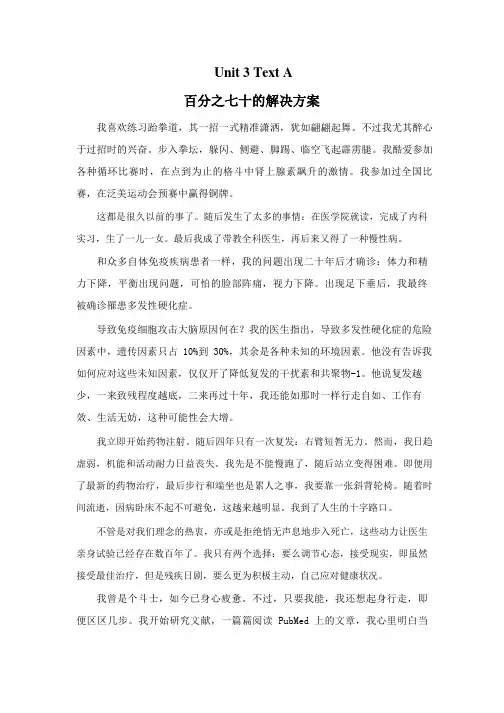
Unit 3 Text A百分之七十的解决方案我喜欢练习跆拳道,其一招一式精准潇洒,犹如翩翩起舞。
不过我尤其醉心于过招时的兴奋。
步入拳坛,躲闪、侧避、脚踢、临空飞起霹雳腿。
我酷爱参加各种循环比赛时,在点到为止的格斗中肾上腺素飙升的激情。
我参加过全国比赛,在泛美运动会预赛中赢得铜牌。
这都是很久以前的事了。
随后发生了太多的事情:在医学院就读,完成了内科实习,生了一儿一女。
最后我成了带教全科医生,再后来又得了一种慢性病。
和众多自体免疫疾病患者一样,我的问题出现二十年后才确诊:体力和精力下降,平衡出现问题,可怕的脸部阵痛,视力下降。
出现足下垂后,我最终被确诊罹患多发性硬化症。
导致免疫细胞攻击大脑原因何在?我的医生指出,导致多发性硬化症的危险因素中,遗传因素只占 10%到 30%,其余是各种未知的环境因素。
他没有告诉我如何应对这些未知因素,仅仅开了降低复发的干扰素和共聚物-1。
他说复发越少,一来致残程度越底,二来再过十年,我还能如那时一样行走自如、工作有效、生活无妨,这种可能性会大增。
我立即开始药物注射。
随后四年只有一次复发:右臂短暂无力。
然而,我日趋虚弱,机能和活动耐力日益丧失。
我先是不能慢跑了,随后站立变得困难。
即便用了最新的药物治疗,最后步行和端坐也是累人之事,我要靠一张斜背轮椅。
随着时间流逝,因病卧床不起不可避免,这越来越明显。
我到了人生的十字路口。
不管是对我们理念的热衷,亦或是拒绝悄无声息地步入死亡,这些动力让医生亲身试验已经存在数百年了。
我只有两个选择:要么调节心态,接受现实,即虽然接受最佳治疗,但是残疾日剧,要么更为积极主动,自己应对健康状况。
我曾是个斗士,如今已身心疲惫。
不过,只要我能,我还想起身行走,即便区区几步。
我开始研究文献,一篇篇阅读 PubMed 上的文章,我心里明白当今临床治疗萌发于数年或数十年前的基础科学文献所撒的种子。
我希望能找到阻止我日益恶化残疾的魔弹。
一开始,我寻找多发性硬化症药物的最新动物实验文章。

第三单元Passage A[参考译文]教育之道:东方和西方1.一位来自加拿大的老师最近参观了一所日本的小学。
在一堂课上,她观看了60个小孩子在学习画猫。
任课老师在黑板上画了一个大圆圈,60个孩子就模仿着画在纸上。
老师在第一个圆圈上面画了一个小些的圆圈,然后又在小圆圈上面画了两个三角形;孩子们也以完全相同的方式继续画着他们的猫。
这堂课就这么继续着,直到教室里有了61只一模一样的猫。
2. 这节课让那位加拿大老师大为吃惊。
这类教学方法--以及它们的效果--同她自己国家的迥然不同。
加拿大学校里的一节美术课会产生满满一屋子独一无二的图画,而不是一张又一张完全相同的猫。
为什么呢? 是什么造成了这种教学方法上的不同呢?3.在任何国家的任何一个教室里,老师教的都不仅仅是艺术、历史或语言。
课堂活动的一部分--有意识或无意识地--是在传授文化:社会的观念、价值观和信仰。
每一种教育制度都不可避免地是一面反映其所在社会的文化的镜子。
4. 在像美国或加拿大这样由许多不同的民族、宗教团体和文化取向构成的西方社会中,个性和独立思考受到高度重视。
这些价值观通过这些国家的教育制度反映出来。
老师们强调那些使每个学生都与众不同的品质。
他们很少要求学生熟记信息;却鼓励他们独立思考,独自寻找答案,并提出各自的解决方法。
学生们从小就学着形成自己的意见和看法,并在课堂讨论中各抒己见。
5. 在日本则截然不同,绝大多数人有着同样的语言、历史和文化。
也许是由于这个缘故,那儿的教育制度反映了一种对集体目标和传统而不是对个性的信念。
日本的学童经常在一起学习,做作业时相互帮助。
在教室里,教师是主要的知识来源:教师讲,学生听。
没有很多的讨论;学生们却要背诵他们已经记住的规则或信息。
6. 日本教育制度的优点是那儿的学生能学到合作的社交技能。
另一个优点是他们学的数学和自然科学比大多数美国学生多得多。
他们每天学习的时数和每年学习的天数也比北美的学生多。
这种制度要求高,但它却使孩子们能为进入一个重视纪律和自制的社会作好准备。
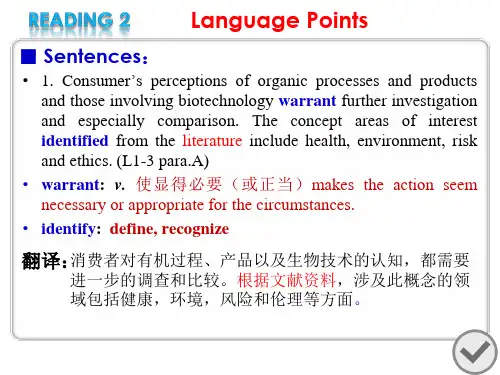

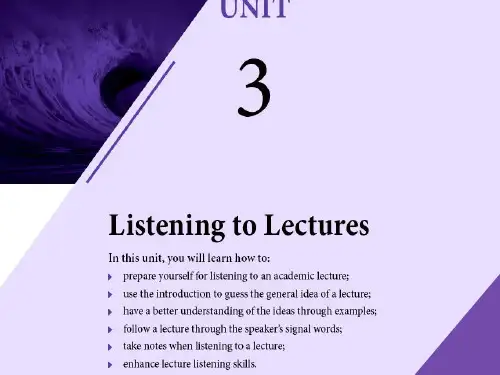

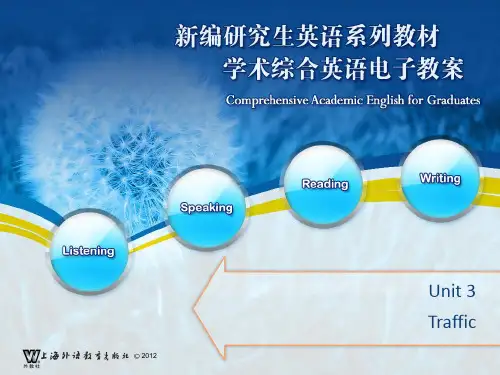

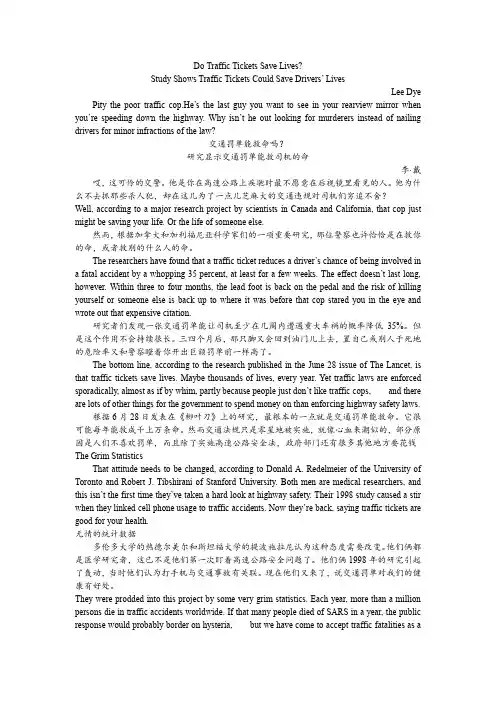
Do Traffic Tickets Save Lives?Study Shows Traffic Tickets Could Save Drivers’ LivesLee Dye Pity the poor traffic cop.He’s the last guy you want to see in your rearview mirror when you’re speeding down the highway. Why isn’t he out looking for murderers instead of nailing drivers for minor infractions of the law?交通罚单能救命吗?研究显示交通罚单能救司机的命李·戴哎,这可怜的交警。
他是你在高速公路上疾驰时最不愿意在后视镜里看见的人。
他为什么不去抓那些杀人犯,却在这儿为了一点儿芝麻大的交通违规对司机们穷追不舍?Well, according to a major research project by scientists in Canada and California, that cop just might be saving your life. Or the life of someone else.然而,根据加拿大和加利福尼亚科学家们的一项重要研究,那位警察也许恰恰是在救你的命,或者救别的什么人的命。
The researchers have found that a traffic ticket reduces a driver’s chance of being involved in a fatal accident by a whopping 35 percent, at least for a few weeks. The effect doesn’t last long, however. Within three to four months, the lead foot is back on the pedal and the risk of killing yourself or someone else is back up to where it was before that cop stared you in the eye and wrote out that expensive citation.研究者们发现一张交通罚单能让司机至少在几周内遭遇重大车祸的概率降低35%。

学术英语unit1,unit3,unit4,unit9课文翻译Unit 1 Text A神经过载与千头万绪的医生患者经常抱怨自己的医生不会聆听他们的诉说。
虽然可能会有那么几个医生确实充耳不闻,但是大多数医生通情达理,还是能够感同身受的人。
我就纳闷为什么即使这些医生似乎成为批评的牺牲品。
我常常想这个问题的成因是不是就是医生所受的神经过载。
有时我感觉像变戏法,大脑千头万绪,事无巨细,不能挂一漏万。
如果病人冷不丁提个要求,即使所提要求十分中肯,也会让我那内心脆弱的平衡乱作一团,就像井然有序同时演出三台节目的大马戏场突然间崩塌了一样。
有一天,我算过一次常规就诊过程中我脑子里有多少想法在翻腾,试图据此弄清楚为了完满完成一项工作,一个医生的脑海机灵转动,需要处理多少个细节。
奥索里奥夫人 56 岁,是我的病人。
她有点超重。
她的糖尿病和高血压一直控制良好,恰到好处。
她的胆固醇偏高,但并没有服用任何药物。
她锻炼不够多,最后一次DEXA 骨密度检测显示她的骨质变得有点疏松。
尽管她一直没有爽约,按时看病,并能按时做血液化验,但是她形容自己的生活还有压力。
总的说来,她健康良好,在医疗实践中很可能被描述为一个普通患者,并非过于复杂。
以下是整个 20 分钟看病的过程中我脑海中闪过的念头。
她做了血液化验,这是好事。
血糖好点了。
胆固醇不是很好。
可能需要考虑开始服用他汀类药物。
她的肝酶正常吗?她的体重有点增加。
我需要和她谈谈每天吃五种蔬果、每天步行30 分钟的事。
糖尿病:她早上的血糖水平和晚上的比对结果如何?她最近是否和营养师谈过?她是否看过眼科医生?足科医生呢?她的血压还好,但不是很好。
我是不是应该再加一种降血压的药?药片多了是否让她困惑?更好地控制血压的益处和她可能什么药都不吃带来的风险孰重孰轻?骨密度 DEXA 扫描显示她的骨质有点疏松。
我是否应该让她服用二磷酸盐,因为这可以预防骨质疏松症?而我现在又要给她加一种药丸,而这种药需要详细说明。
DoTrffic Tickets Sve Lives?Study Shows Trffic Tickets CouldSve Drivers ’ LivesL ee Dye Pity the poor trffic cop. He ’s the lst guy you wnt to see in your rerview mirror when you ’ re speeding down the highwy. Why isn’t he out looking for murderers insted of niling drivers for minor infrctions of the lw?交通罚单能救命吗?研究显示交通罚单能救司机的命李·戴哎,这可怜的交警。
他是你在高速公路上飞奔时最不情愿在后视镜里看见的人。
他为什么不去抓那些杀人犯,却在这儿为了一点儿芝麻大的交通违规对司机们穷追不舍?Well, ccordingto mjor reserch project by scientists in CndndCliforni, tht copjustmight be sving your life. Or the life of someone else.然而,根据加拿大和加利福尼亚科学家们的一项重要研究,那位 JC 也许恰恰是在救你的命,或者救别的什么人的命。
The reserchers hve found tht trffic ticket reduces driver’s chnce of beinginvolved in ftl ccident by whopping 35 percent, t lest for few weeks. The effect doesn’t lst long, however. Within three tofour months, the ledfoot is bck on the pedlnd the risk of killing yourself or someone else is bck up to where it ws before tht copstred you in the eye nd wrote out tht expensive cittion.研究者们发现一张交通罚单能让司机至少在几周内遭遇重大车祸的概率降低 35% 。
UNIT 3 Unemployment1. Losing a job can be the most distressing economic event in a person’s life. Most people rely on their labor earnings to maintain their standard of living, and many people get from their work not only income but also a sense of personal accomplishment.A job loss means a lower living standard in the present, anxiety about the future, and reducedself-esteem. It is not surprising, therefore, that politicians campaigning for office often speak about how their proposed policies will help create jobs.失去一份工作可能是最痛苦的经济事件在一个人的生活。
大多数人们依靠自己的劳动收入来维持他们的生活标准,许多人会从他们的工作得到的不仅是收入,还有自己的成就感。
一个失去工作意味着现在要定一个更低的生活标准,焦虑未来,并丧失自尊心。
这并不奇怪,因此,政治家竞选办公室经常谈论他们所提出的政策将帮助创造就业机会。
4.In judging how serious the problem of unemployment is, one question to consider is whether unemployment is typically a short-term or long-term condition. If unemployment is short-term, one might conclude that it is not a big problem. Workers may require a few weeks between jobs to find the openings that best suit their tastes and skills. Yet if unemployment is long-term, one might conclude that it is a serious problem. Workers unemployed for many months are more likely to suffer economic and psychological hardship.判断失业问题有多么严重时,其中一个问题就是要考虑是否失业通常是一个短期或长期的条件。